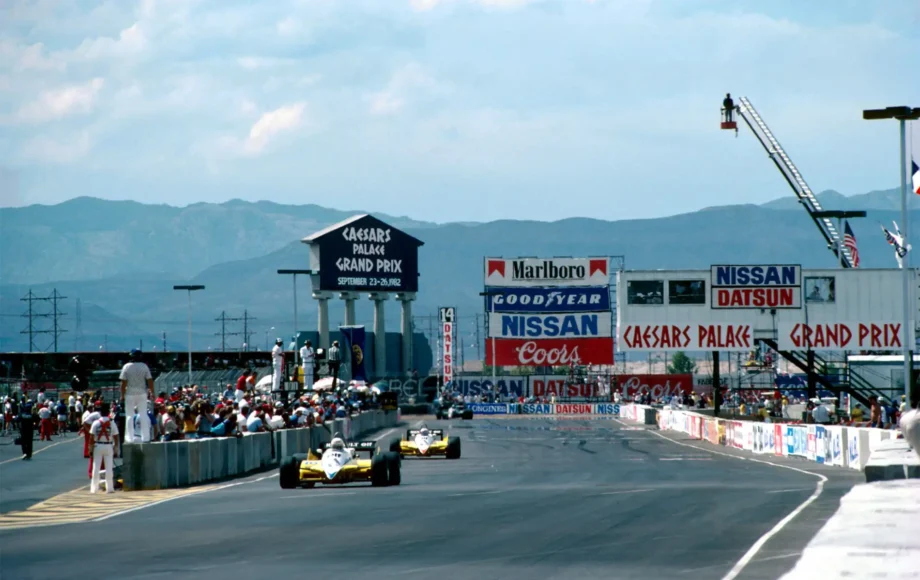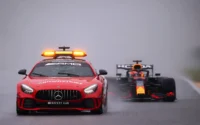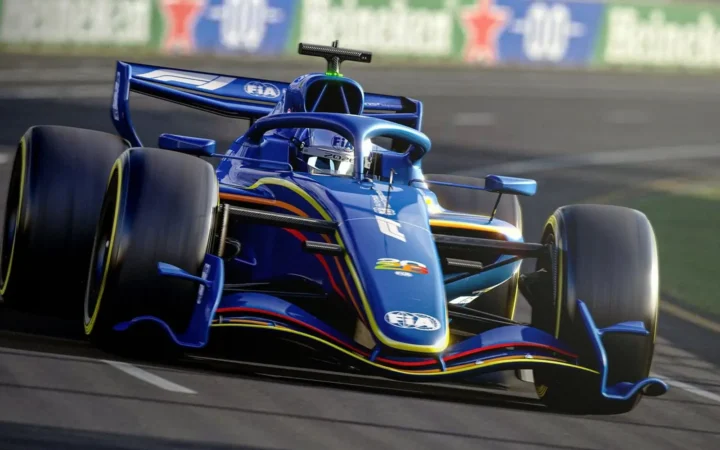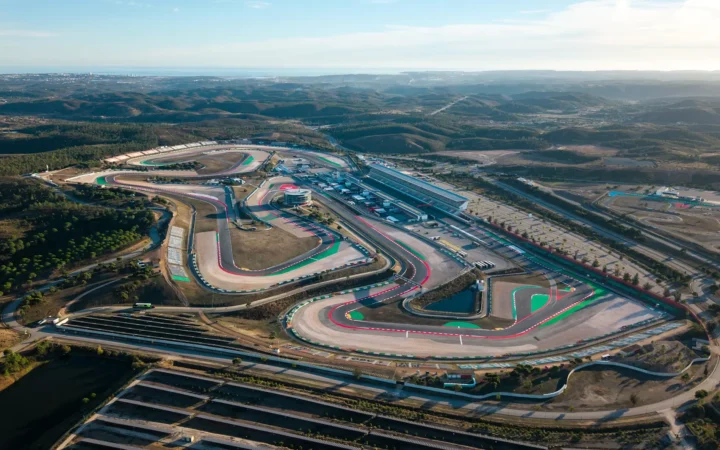The year was 1981. Ronald Reagan was president, the world witnessed the inaugural flight of the space shuttle Columbia, and the United States was grappling with soaring inflation rates. Amidst these national and global events, the city of Las Vegas, already renowned for its glitz and glamour, was gearing up to host an unprecedented event in its colourful history – its very first Formula One race.
Instead of cars zooming down the Las Vegas Strip, which we witnessed in 2023, the spectacle of F1 cars was confined to a specially designed 2.2-mile, 14-turn track, ingeniously laid out in the expansive parking lot of the Caesars Palace resort. In this race review, we will revisit the memorable events of that race, the Drivers’ Championship and a hiatus for Australian F1 fans.
1981 Drivers’ Championship on the line
The 1981 Caesars Palace Grand Prix, held on 17 October in the bustling city of Las Vegas, Nevada, was the 15th and final race of the 1981 season. The race unfolded over 75 laps, with Australian Alan Jones claiming the win for Williams. Frenchman Alain Prost, driving for Renault, claimed second, while Italian driver Bruno Giacomelli secured third, driving for Alfa Romeo.
Below the podium positions, Brazilian driver Nelson Piquet finished fifth in his Brabham-Ford, which was enough to clinch the 1981 Drivers’ Championship, just a mere point ahead of Jones’s Argentine teammate Carlos Reutemann. Reutemann, who had started on pole, crossed the finish line in eighth.
The 1981 Caesars Palace Grand Prix also marked a notable moment in Australian motorsport history. Alan Jones’s win in Las Vegas would stand as the last win by an Australian in Formula 1 until Mark Webber‘s triumph at the 2009 German Grand Prix, highlighting a long interlude before Australia’s next success in F1.
As the 1981 Caesars Palace Grand Prix approached, the World Championship hung in the balance with three drivers vying for the title. Argentine Carlos Reutemann, driving for Williams-Ford, led the standings with 49 points and two race victories. Hot on his heels was Brazilian Nelson Piquet in the Brabham-Ford, with 48 points and three wins under his belt. French driver Jacques Laffite remained an outside contender with 43 points, with two wins, including his most recent victory in Canada.
Laffite’s path to the championship was slim. He needed a win in Las Vegas, with Reutemann finishing no better than fourth and Piquet not placing third or higher. Alternatively, a second-place finish would be enough for Laffite, provided neither Reutemann nor Piquet managed to break into the top six. In a scenario where Laffite won, Piquet came third, and Reutemann fourth, all three would end the season tied at 52 points. In this tie-break situation, Laffite’s edge would come from his tally of second-place finishes (two compared to Piquet’s one), crowning him the champion. Similarly, if Laffite finished second with neither Reutemann nor Piquet scoring, he and Reutemann would be tied at 49 points. Here, Laffite’s advantage would lie in his greater number of third-place finishes (three against Reutemann’s two).
For Laffite, any result short of first or second place meant the championship would slip away.
Reutemann’s route to the championship was simple. Finish ahead of Piquet.
Meanwhile, Piquet needed to secure a place in the top five and outperform Reutemann to clinch the title. These various possibilities set the stage for a suspense-filled finale in the 1981 season.
What happened in the 1981 Caesars Palace Grand Prix?
Opening laps
As the race started, Alan Jones surged, seizing the lead from pole-sitter Carlos Reutemann, who quickly lost ground, overtaken by Gilles Villeneuve, Alain Prost, and Bruno Giacomelli. He dropped to fifth by the end of the first lap, and by the end of the second, Jones had already built up a commanding five-second lead.
Mid-pack, Patrick Tambay experienced a nervy moment. He lost control of his Ligier and collided with a tyre wall, which was fortunately in front of a concrete barrier. The impact was severe enough to rip off the front of his car, but luckily, Tambay emerged with only minor injuries.
Prost overtook Villeneuve on the third lap, though he couldn’t close the gap to challenge Jones for the lead. Villeneuve, engaged in his own battle, held off Giacomelli, which allowed Mario Andretti to catch up to Nelson Piquet, who was in a tense battle to try to pass Reutemann.
Mid-race battles
On lap 17, the tension peaked as Piquet closely tailed Reutemann, finally overtaking him on the inside when Reutemann braked too early. Piquet later commented on this move, suggesting Reutemann might have hoped for a collision to sway the outcome of the championship in his favour. Andretti followed suit, passing Reutemann on the next lap. Piquet’s race improved as he overtook John Watson on lap 22, positioning himself to score crucial points.
Amidst these battles, Ferrari was looking to call in Villeneuve and retire him on lap 23. It had been announced he was being disqualified for lining up on the grid improperly. He pulled out of the race on that lap anyway due to an engine fire. A few laps later, on lap 30, Andretti, a crowd favourite, withdrew from fourth due to a broken suspension.
Final laps
With just 15 laps remaining and a substantial 40-second lead over Prost, Jones began to pace himself towards the finish. After recovering from an earlier spin, Giacomelli held third place, and Nigel Mansell overtook Piquet for fourth.
Piquet, visibly struggling with physical exhaustion, managed to maintain fifth, enough to secure the two points he needed for the championship. His condition was a major concern as the race neared its end, especially as Reutemann, hindered by gearbox issues and lacking fourth gear, fell to eighth after being overtaken by Watson and Laffite.
In a dramatic final lap, Laffite snatched the last point from Watson at the very last corner, while Giacomelli narrowly missed second place to Prost due to his failing tyres.
After crossing the finish line, Piquet took fifteen minutes to recover from heat exhaustion but secured the vital fifth-place finish, earning him the two points he needed to become the 1981 Drivers’ World Champion.
Nelson Piquet’s first F1 Drivers’ World Championship
Nelson Piquet’s first Formula 1 Drivers’ Championship was the first in his illustrious racing career. He would go on to win again in 1983 and 1987. Competing for the Brabham team at the time, he had displayed remarkable consistency throughout the season to clinch his first title.
Piquet won three races in Argentina, San Marino, and Germany that season. However, his journey to the championship was far from straightforward. The season saw a fierce rivalry, particularly with Carlos Reutemann driving for Williams, who emerged as Piquet’s leading contender for the title.
Heading into the season’s final race in Vegas, Piquet was just one point behind Reutemann in the standings. The championship was poised on a knife-edge, with the Las Vegas race set to be the decider. Despite physical exhaustion from the heat and the challenging conditions of the track, he managed to secure fifth, a result, when combined with Reutemann’s issues ensured that Piquet beat his closest rival to the championship bringing national pride in Brazil and cementing his legacy in F1 history.
The audacity of the 1981 Caesars Palace Grand Prix
The Las Vegas Review-Journal, through the words of reporter Mike Henle in 1981, captured the essence of this momentous race. Henle noted the sheer audacity and entrepreneurial spirit of the local hoteliers who managed to bring the race to Southern Nevada, a region previously unkown for motorsport.
The race garnered significant international attention. It was broadcast in 31 countries, including the United States, and attracted an astonishing 83 million viewers. The event not only put Las Vegas on the map for motorsports but also reinforced the city’s reputation as a place where the impossible becomes possible.
Reflecting on the event, Henle summed up the race in his report: “The Caesars Palace Grand Prix is proof that nothing is impossible in Las Vegas,” he wrote. “Don’t ever count out an event in a town which has built its reputation around taking chances.”
1981 Caesars Palace Grand Prix Race Results
| Pos | No | Driver | Car | Laps | Time/retired | Pts |
|---|---|---|---|---|---|---|
| 1 | 1 | Alan Jones | Williams Ford | 75 | 1:44:09.077 | 9 |
| 2 | 15 | Alain Prost | Renault | 75 | +20.050s | 6 |
| 3 | 23 | Bruno Giacomelli | Alfa Romeo | 75 | +20.430s | 4 |
| 4 | 12 | Nigel Mansell | Lotus Ford | 75 | +47.470s | 3 |
| 5 | 5 | Nelson Piquet | Brabham Ford | 75 | +76.440s | 2 |
| 6 | 26 | Jacques Laffite | Ligier Matra | 75 | +78.180s | 1 |
| 7 | 7 | John Watson | McLaren Ford | 75 | +78.500s | 0 |
| 8 | 2 | Carlos Reutemann | Williams Ford | 74 | +1 lap | 0 |
| 9 | 28 | Didier Pironi | Ferrari | 73 | +2 laps | 0 |
| 10 | 20 | Keke Rosberg | Fittipaldi Ford | 73 | +2 laps | 0 |
| 11 | 29 | Riccardo Patrese | Arrows Ford | 71 | +4 laps | 0 |
| 12 | 8 | Andrea de Cesaris | McLaren Ford | 69 | +6 laps | 0 |
| 13 | 4 | Michele Alboreto | Tyrrell Ford | 67 | DNF | 0 |
| NC | 14 | Eliseo Salazar | Ensign Ford | 61 | +14 laps | 0 |
| NC | 36 | Derek Warwick | Toleman Hart | 43 | DNF | 0 |
| NC | 22 | Mario Andretti | Alfa Romeo | 29 | DNF | 0 |
| DQ | 27 | Gilles Villeneuve | Ferrari | 22 | DSQ | 0 |
| NC | 6 | Hector Rebaque | Brabham Ford | 20 | DNF | 0 |
| NC | 33 | Marc Surer | Theodore Ford | 19 | DNF | 0 |
| NC | 3 | Eddie Cheever | Tyrrell Ford | 10 | DNF | 0 |
| NC | 16 | Rene Arnoux | Renault | 10 | DNF | 0 |
| NC | 25 | Patrick Tambay | Ligier Matra | 2 | DNF | 0 |
| NC | 11 | Elio de Angelis | Lotus Ford | 2 | DNF | 0 |
| NC | 32 | Jean-Pierre Jarier | Osella Hart | 0 | DNF | 0 |
1981 Post-Race F1 Championship Standings
1981 Post-Race F1 Drivers’ Championship Standings
| Pos | Driver | Nationality | Car | PTS |
|---|---|---|---|---|
| 1 | Nelson Piquet | BRA | Brabham Ford | 50 |
| 2 | Carlos Reutemann | ARG | Williams Ford | 49 |
| 3 | Alan Jones | AUS | Williams Ford | 46 |
| 4 | Jacques Laffite | FRA | Ligier Matra | 44 |
| 5 | Alain Prost | FRA | Renault | 43 |
| 6 | John Watson | GBR | McLaren Ford | 27 |
| 7 | Gilles Villeneuve | CAN | Ferrari | 25 |
| 8 | Elio de Angelis | ITA | Lotus Ford | 14 |
| 9 | Rene Arnoux | FRA | Renault | 11 |
| 9 | Hector Rebaque | MEX | Brabham Ford | 11 |
| 11 | Riccardo Patrese | ITA | Arrows Ford | 10 |
| 11 | Eddie Cheever | USA | Tyrrell Ford | 10 |
| 13 | Didier Pironi | FRA | Ferrari | 9 |
| 14 | Nigel Mansell | GBR | Lotus Ford | 8 |
| 15 | Bruno Giacomelli | ITA | Alfa Romeo | 7 |
| 16 | Marc Surer | SUI | Theodore Ford | 4 |
| 17 | Mario Andretti | USA | Alfa Romeo | 3 |
| 18 | Patrick Tambay | FRA | Ligier Matra | 1 |
| 18 | Andrea de Cesaris | ITA | McLaren Ford | 1 |
| 18 | Slim Borgudd | SWE | ATS Ford | 1 |
| 18 | Eliseo Salazar | CHI | Ensign Ford | 1 |
1981 Post-Race F1 Constructors’ Championship Standings
| Pos | Team | PTS |
|---|---|---|
| 1 | Williams Ford | 95 |
| 2 | Brabham Ford | 61 |
| 3 | Renault | 54 |
| 4 | Ligier Matra | 44 |
| 5 | Ferrari | 34 |
| 6 | McLaren Ford | 28 |
| 7 | Lotus Ford | 22 |
| 8 | Arrows Ford | 10 |
| 9 | Alfa Romeo | 10 |
| 10 | Tyrrell Ford | 10 |
| 11 | Ensign Ford | 5 |
| 12 | Theodore Ford | 1 |
| 13 | ATS Ford | 1 |
Seen in:






